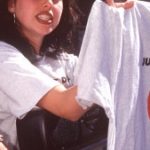A Father, A Son, And A Machine
Evan Rosenbaum was 2 years old when his father brought home the Power Macintosh 7100.
This was 1994, and the 7100, a new personal computer from Apple, was a hefty gray console, hardly anything to look at. (It would be three years before Steve Jobs fatefully met the designer Jony Ive.) Nevertheless, the computer was cutting edge at the time, and Rosenbaum’s father, Howard, an accountant with entrepreneurial aspirations, unboxed it with delight. He installed it in the wood-paneled den overlooking the backyard of his Long Island home.

“I just remember how excited he was, setting it up, seeing what it could do,” Rosenbaum says. Howard sat his young son on his lap, and together they explored the computer. His father showed Rosenbaum how to move the mouse around, how to type on the keyboard. They tried out various applications, including AppleWorks, a drawing program, and HyperCard, a user-friendly programming tool. Similar joyful moments at the computer repeated themselves many times over the next few months.
But then, Howard passed away suddenly, stricken with a heart attack at 35. Since Rosenbaum himself was only 2, the memories of the 7100 emerged as his strongest—almost his only—memories of his dad. Over the next few years, Rosenbaum began to associate the machine very strongly with his father. More than in the framed photos around the house, more even than at his gravesite, Howard seemed to live on, for his son, in that humming gray console in the wood-paneled den.
When Rosenbaum turned 3, then 4, he spent more and more time with the 7100. He played Sim City on it, but soon realized he was more interested in creating his own games than playing ones others had made. He became adept at Hypercard, programming a Tic-Tac-Toe game on his own. Anytime Rosenbaum had a moment of joyful discovery on the 7100, he remembered the same excitement his father had expressed playing with it.
Rosenbaum didn’t realize the degree to which he associated his dad with the 7100 until the year he turned 6. That year, the 7100 began to slow down considerably. There were applications he had seen on other kids’ computers—PrintMaster, Kid Pix—that couldn’t run on the 7100. He realized that you couldn’t use the same computer forever, that there was such a thing as a hardware upgrade. Without thinking too heavily about the implications, he asked his mother for a new machine.
One day in September, just as kindergarten was about to begin, the Sony Vaio came. Rosenbaum and his mother set it up on the desk next to the 7100. He looked at the Vaio, he recalls, with a “mix of sadness and joy.” He was excited to have the new computer. But he couldn’t bear to get rid of the old one yet. If his mother proposed bringing the 7100 up to the attic, he resisted. He would still need to use some applications on the 7100 for a while, he explained to her. She left him alone with the two computers side by side.
Rosenbaum hesitated to turn on the Vaio. “I knew the moment I pressed that power button, I’d be losing a day-to-day connection with him,” he says, referring to Howard. Finally, he steeled himself, and switched on the Vaio.
Its opening animation came up, and Rosenbaum felt a glimmer of excitement: “It was a moment of joy that helped end the moment of sadness,” he says. He began to play around on the new machine, just as he and his father had played around on the 7100. The connection with his father was about the joy of exploring computers generally, he tried to tell himself. Not about one particular machine.
Even so, for the next several months, as he got acquainted with the Vaio, Rosenbaum insisted on keeping the 7100 nearby. Every week, his mother would suggest they take it up to the attic, and every week, Rosenbaum would find a reason to keep it in the den. Finally, he relented. His mother took the 7100 upstairs and into the bathroom, where a door at the rear of a closet led to an elevated attic space. She left the 7100 up there and closed the door behind it.
It wasn’t easy letting go, Rosenbaum says. But he knew Howard would have wanted him to upgrade to a better computer. “He wouldn’t want me to be stuck in the past, using a computer from the early ’90s forever.”
Rosenbaum became adept at the Vaio. As before, whenever he made a discovery on the new machine—when he learned to record TV shows with a TV tuner card, for instance—he knew it was a moment that would have thrilled his dad.
Yet even as he tried to become platform-agnostic about the way he associated his memory of his father with computers, Rosenbuam still felt a strong pull to the 7100. In the months following its move to the attic, Rosenbaum would occasionally be brushing his teeth and glance at the closet. Every so often he’d go inside, open the door at the rear, climb a step or two so that his head was level with the 7100, and look at it.
In 2002, his mother purchased an iMac, restoring Apple to the Rosenbaums’ home. (A Powerbook G4 and a MacbookPro would follow.) Rosenbaum was using Apple machines again on a day-to-day basis, and his attachment to the 7100 in the attic grew more faint, his visits to it more sporadic.
At age 14, he watched Steve Jobs give the keynote announcing the iPhone. The excitement in Jobs’s voice was palpable, and not unlike his own father’s excitement over the 7100 all those years ago. And though the initial iPhone didn’t open its ecosystem broadly to developers, that didn’t stop Rosenbaum. He founded a platform called iGiki to make apps for Apple’s revolutionary gadget. He juggled high school coursework with correspondence with developers in China he employed. He wrote college essays about his relationship with his father and his founding of iGiki, and soon headed to Wharton School of the University of Pennsylvania. Two years later, Philadelphia magazine would dub him one of the smartest people in the city.
In 2013, about a year before graduating from Wharton, Rosenbaum cofounded a group messaging app called Blend. Today, Rosenbaum is the company’s chief product officer. Blend has over 300,000 active users from around the world, and the company has received over $9 million in venture funding.
Last year, after securing his latest round of funding, Rosenbaum climbed Mount Kilimanjaro. He then flew back to his family home on Long Island, which he hadn’t visited in some time. He caught up with his mother and went upstairs and went to sleep.
The next morning, he entered the bathroom near his room. He went up into the attic space, and there it was: the 7100. A tarp lay draped over it. During Hurricane Sandy, he had called home to ask his mother to cover it, in case the roof leaked.
He removed the tarp and took the computer downstairs to his room. Eager to boot it up, he didn’t bother to clear a space on his desk, setting it up right on the floor. He worried for a moment that the machine might not work at all. It was over 20 years old, after all. But then he heard the familiar rattle of the fan, and icons began to appear on the monitor.
Rosenbaum had done this occasionally over the years, whenever he had hit a major milestone and wanted a moment to relate to his father’s memory more strongly. Now, on the floor of his room, Rosenbaum opened HyperCard and other applications, looking at some of the files they’d created together. As he did so, he engaged in an imagined conversation with his dad. Howard asked how Blend was going, and Rosenbaum told him. His father asked what sort of technology they were using, and Rosenbaum told him. In this back-and-forth, Howard was proud of his son for the traction of his app, for the investment he had secured. He was proud that his son had made good on the spirit of entrepreneurship he himself hadn’t had time to act on.
After a while, Rosenbaum powered down the 7100 and returned it to its resting place. “I felt a sadness bringing it back up to the attic,” he recalls. “But also a joy that I had the opportunity to update him.”
Fast Company , Read Full Story
(19)













